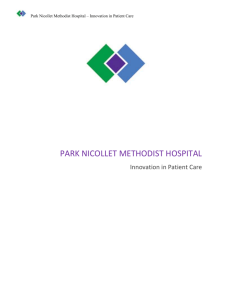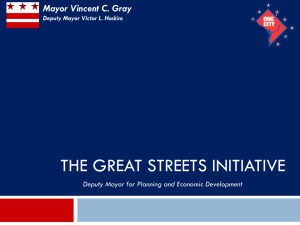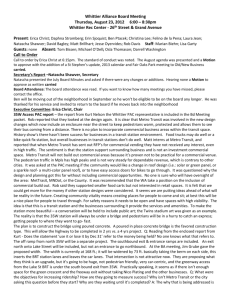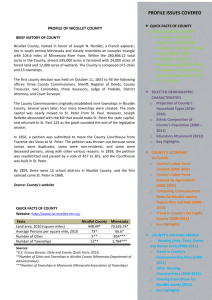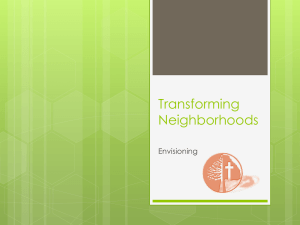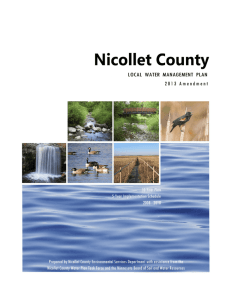Minneapolis Corridor Housing Initiative, Nicollet Avenue Study Area
advertisement
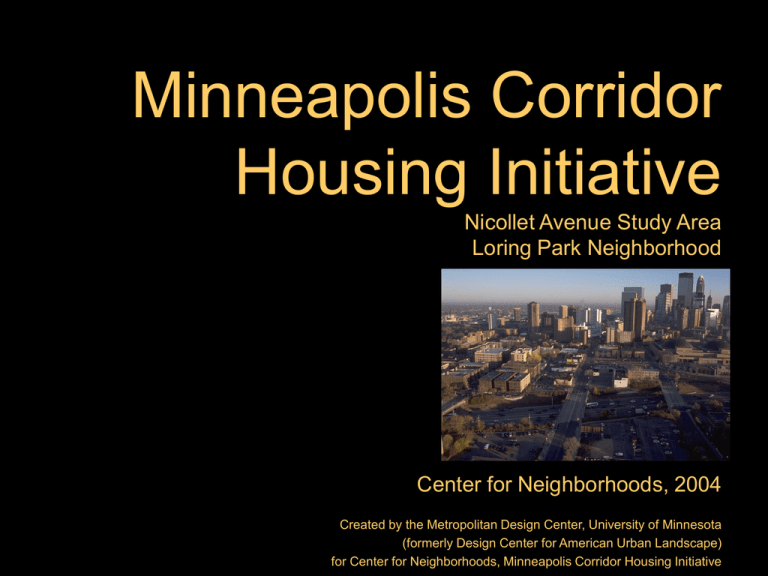
Minneapolis Corridor Housing Initiative Nicollet Avenue Study Area Loring Park Neighborhood Center for Neighborhoods, 2004 Created by the Metropolitan Design Center, University of Minnesota (formerly Design Center for American Urban Landscape) for Center for Neighborhoods, Minneapolis Corridor Housing Initiative Loring Park Presentation Corridor Housing Initiative People in the Loring Park Project Loring Park Timeline Loring Park Sites Site A: Meter Farm Site B: Village Video Site C: Markers Liquor The Eat Street Meet Workshops Development Guidelines Corridor Housing Initiative Aims Center for Neighborhoods The Corridor Housing Initiative demonstrates replicable models of proactive, integrated planning and consensus building among neighborhoods, the city, and the county. The Corridor Housing Initiative produces economically and politically viable development projects tha include affordable housing options along corridors and meet city goals and neighborhood interests. The new Corridor Housing Initiative model(s) and resulting projects produce new affordable housing options more efficiently and effectively than conventional development patterns. People in Loring Park Coordinators: Center for Neighborhoods Neighborhood: Nicollet Avenue Task Force, Citizens for a Loring Park Community (CLPC) Facilitators: Center for Policy, Planning and Performance Design: Design Center for American Urban Landscape Development: Project for Pride in Living Government: City of Minneapolis Loring Park Study Area Timeline August 2003: Loring Park selected for Corridor Initiative through RFP October 2003: First meeting of Steering Committee January-February 2004: Stakeholder/developer roundtables February-March 2004: Community Workshops May 2004: Development guidelines by CLPC Task Force Grant St Loring Park Sites Identified by the neighborhood in previous work, these sites were used as examples to discuss community attitudes and to demonstrate the financial dynamics of development. 14th St A: Meter Farm 15th St 1st Ave Nicollet Ave LaSalle Ave B: Village Video C: Markers Liquor Site A: Meter Farm Base Site Expanded Site 16th St 1st Ave Nicollet Ave 15th St Site A: View from southeast Site A Site B: 15th St Village Video 16th St Base Site 1st Ave I-94 Nicollet Ave Expanded Site Site B: View from southeast Site B 15th St Site C: Marker’s Liquor 16th St Base Site Nicollet Ave LaSalle Ave Expanded Site I-94 Site C: View from southeast Site C The Eat Street Meet Public design and development workshops Workshop 1 (February 19): Formed groups to discuss local priorities and consider the merits and problems of various building heights on Nicollet Avenue. Workshop 2 (March 4): Large group to review information on development costs and discuss local expectations for housing and development on Nicollet Avenue. Eat Street Meet 1: Building Height Comparisons Nicollet Avenue today: South Entry to Loring Park Neighborhood Nicollet Avenue with 5-story building heights Nicollet Avenue with 10-story building heights The Eat Street Meet 1: Neighborhood Design Priorities Overall, residents were: • Receptive to taller buildings than zoning currently allows • Concerned about parking • Supportive of affordable housing • Interested in enhancing the “Eat Street” pedestrian character of Nicollet Avenue Handout examples The Eat Street Meet 2: Development Demonstration • Workshop presented three development scenarios for Site C to demonstrate how costs vary by construction types and size of unit 4 stories 6 stories 10 stories Development Costs Variable Height Total cost Number of units (at 24 or 19 units per floor) Cost per unit Scenario 1 Scenario 2 Scenario 3 4 floors (wood) 6 floors (concrete) 10 floors (concrete) $15,962,500 $27,025,000 $43,525,000 72 - 57 $165,000 - $208,000 120 - 95 $192,000 - $242,000 216 - 171 $184,000 - $232,000 Assumptions: Acquisition cost $1,000,000; construction costs: commercial $90/s.f., residential wood $85/s.f., residential concrete $120/s.f.; floor plate size 30,000 s.f.; soft costs 25% of construction costs; structured parking spaces $15,000 each Development Guidelines CLPC’s Nicollet Avenue Task Force drafted guidelines that address: • • • • • • • • Mix of uses Movement and connectivity Neighborhood history and character Open space Parking infrastructure Coordinated site planning Developer and community planning and design process Building heights and setbacks Guidelines are available at www.loringpark.org Credits © 2004 Metropolitan Design Center, College of Architecture and Landscape Architecture, University of Minnesota and the Center for Neighborhoods. The Design Center is solely responsible for statements and errors in the materials. Permission is granted for use of this presentation for non-profit educational purposes. Acknowledgement is required. Stand-alone use of Design Center images is permitted with acknowledgement. Design Center Project Team: Ann Forsyth, Director (Loring Park contact) Dan Marckel, Senior Research Fellow Frank Fitzgerald, Research Fellow Wira Noeradi, Research Fellow Nathan Burt, Research Assistant Ian Kaminski-Coughlin, Research Assistant Jorge Salcedo, Research Assistant Katie Thering, Research Specialist David Lowe, Office Specialist II Metropolitan Design Center 1 Rapson Hall 89 Church Street Minneapolis, MN 55455 612-625-9000 www.designcenter.umn.edu
